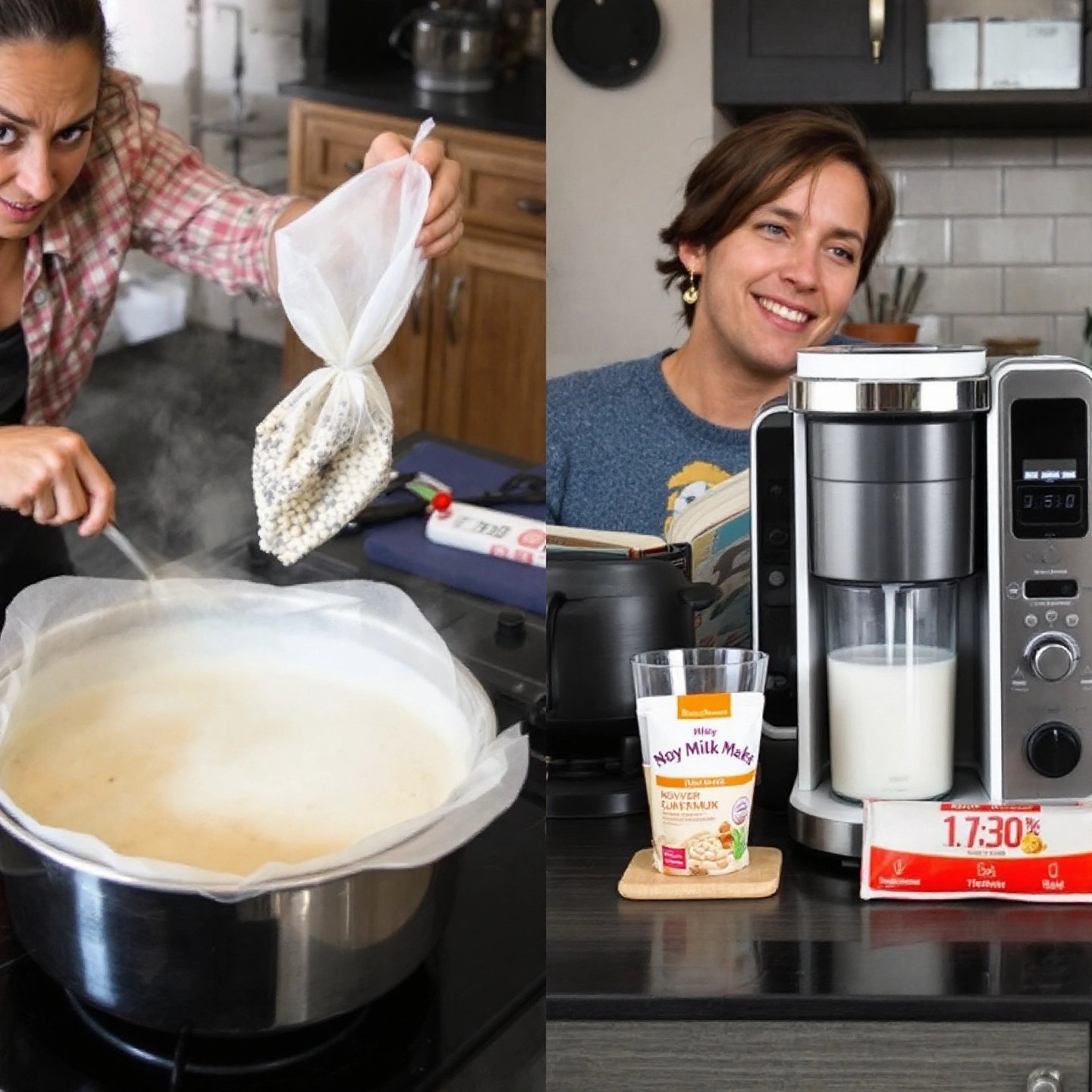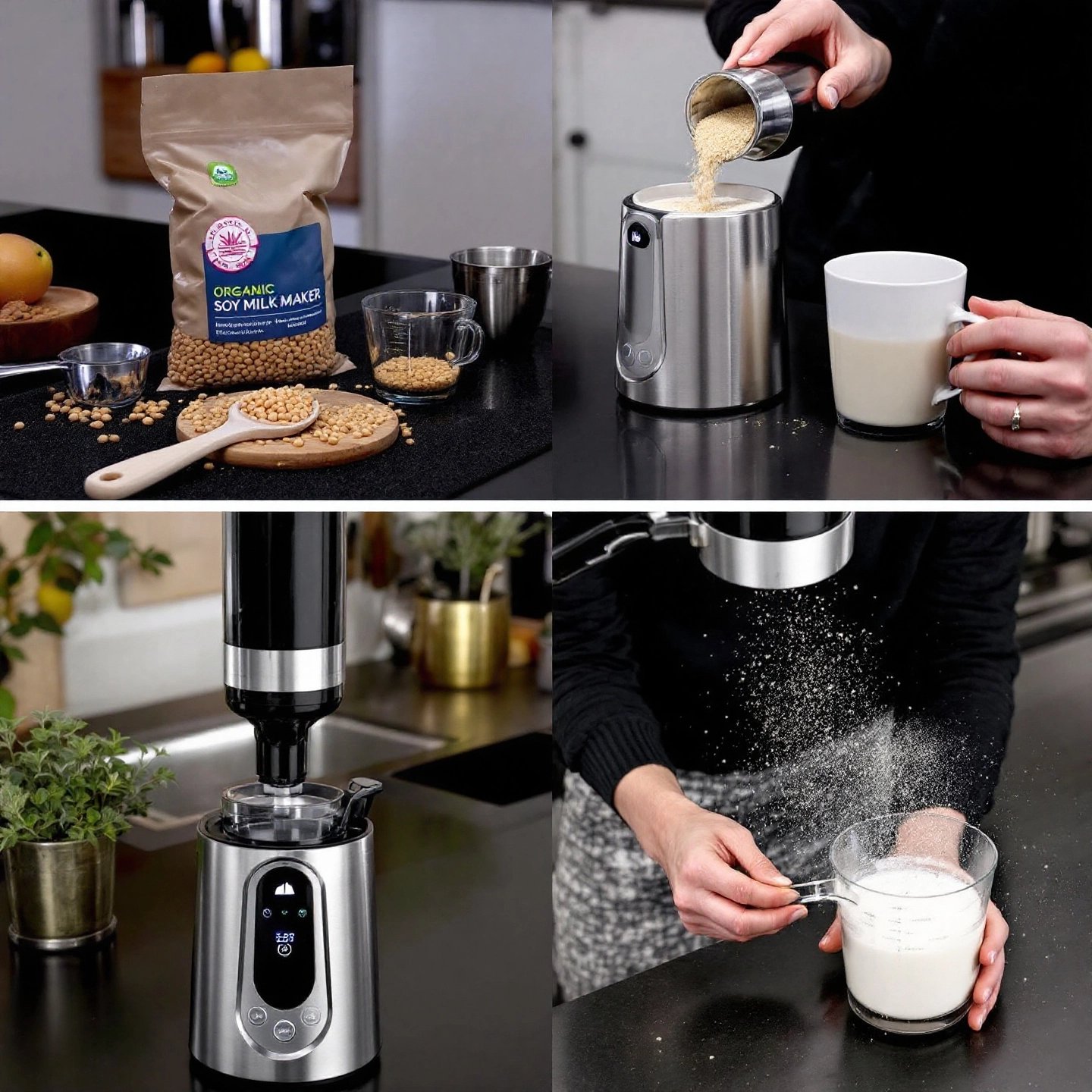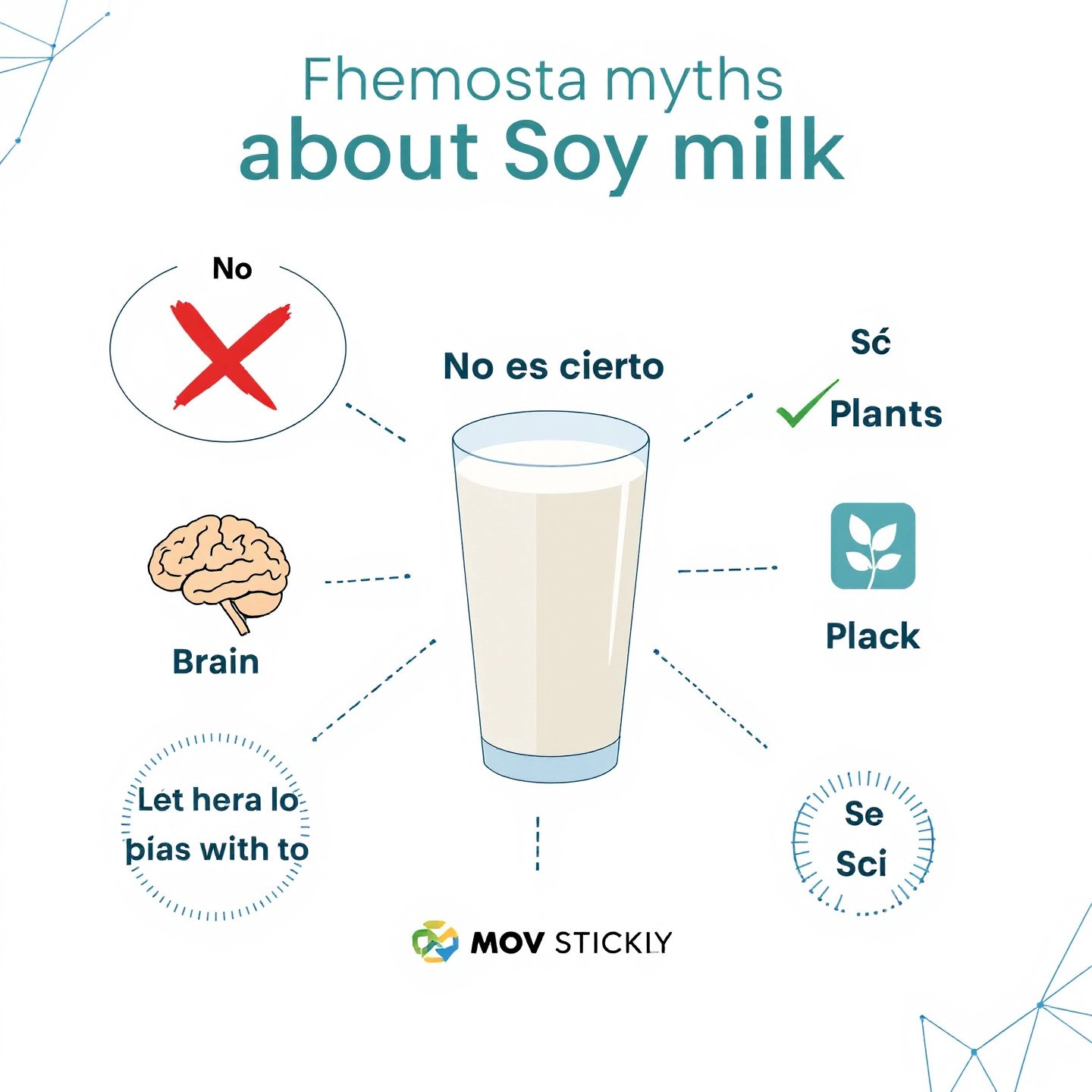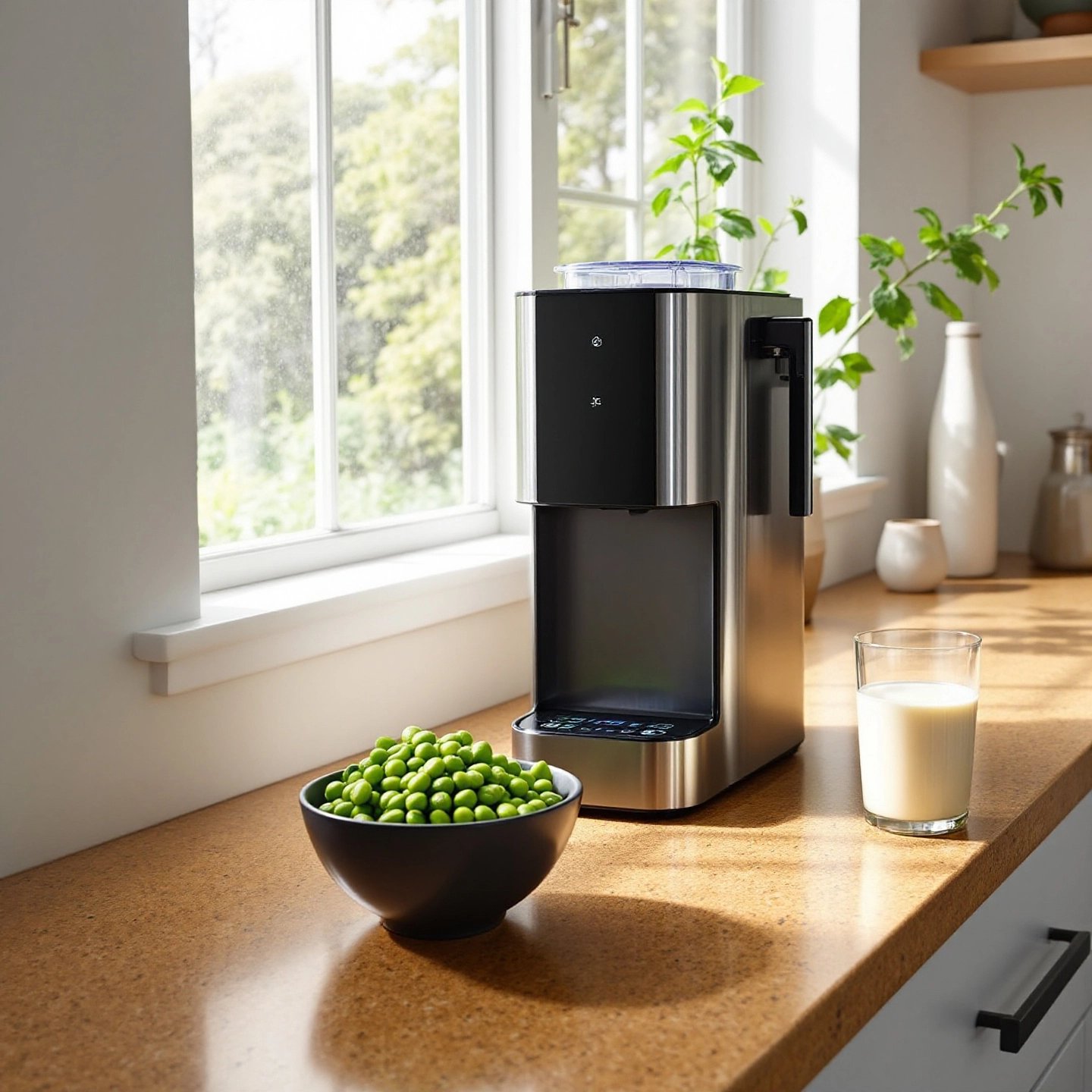Introduction to Soy Milk Maker
Imagine waking up to the aroma of fresh, homemade soy milk, tailored exactly to your taste preferences. Sounds delightful, doesn’t it? A soy milk maker makes this possible, transforming the labor-intensive process of making soy milk into a simple, automated task. This nifty kitchen appliance is akin to a combination of a blender and an automatic coffee maker, allowing you to enjoy homemade soy milk without the hassle of soaking, grinding, and cooking the soybeans manually.
Why might you consider investing in a soy milk maker? For one, it offers the advantage of consuming fresh, additive-free soy milk, a preference for many health-conscious individuals. Commercially available soy milk often contains preservatives and sweeteners, which you can easily avoid by making your own. Plus, homemade soy milk allows you to control the sugar content, an essential factor for those mindful of their dietary intake.
The benefits of owning a soy milk maker extend beyond health. These machines simplify the production process, ensuring a consistent texture and flavor every time. They are versatile, capable of making not just soy milk but also other plant-based milks such as almond or rice milk. This versatility means you can experiment with different recipes and flavors, tailoring each batch to your unique preferences.
In this guide, we will walk you through the essential aspects of choosing the right soy milk maker, mastering its use, exploring delicious recipes, and maintaining your machine for longevity. Whether you are new to plant-based milks or a seasoned enthusiast, this guide will provide you with valuable insights to enhance your homemade soy milk experience.

Understanding Why Soy Milk Makers Are Worth the Investment
Have you ever wondered why so many people are turning to soy milk makers? These handy appliances offer numerous benefits that make the investment worthwhile, especially for those who enjoy the taste and health benefits of homemade soy milk. Let’s explore the key advantages that set soy milk makers apart from traditional methods.
Convenience and Time-Saving
- Automated Process: Unlike the traditional stovetop method, which involves soaking, boiling, and straining, soy milk makers automate these steps, delivering fresh soy milk with minimal effort.
- Quick Preparation: Most machines can produce soy milk in under 30 minutes, allowing you to enjoy a nutritious beverage without spending hours in the kitchen.
- Consistent Results: With preset programs, these machines ensure consistent texture and flavor, so you get the perfect cup every time.
Cost-Effectiveness
- Economical Ingredients: Soybeans are inexpensive, and with a soy milk maker, a small amount goes a long way, producing multiple servings at a fraction of the cost of store-bought soy milk.
- Reduced Waste: By making soy milk at home, you can reduce packaging waste, contributing to a more sustainable lifestyle.
Nutritional Advantages
- Preservative-Free: Homemade soy milk is free from preservatives and additives, offering a purer and healthier alternative to commercial options.
- Customization: You can adjust sweetness, flavor, and thickness to meet your dietary needs and taste preferences, whether you prefer unsweetened, vanilla-flavored, or a richer texture.
- Rich in Nutrients: Soy milk made at home retains more nutrients, including protein, fiber, and essential vitamins, ensuring a wholesome drink.
In summary, the advantages of soy milk makers extend beyond convenience and cost-effectiveness. They offer a healthier, customizable, and environmentally friendly way to enjoy soy milk. As we delve into the next section, we’ll explore the key features to consider when choosing the best soy milk maker for your needs.
Factors to Consider Before Choosing a Soy Milk Maker
When it comes to selecting the best soy milk maker for your kitchen, several features can significantly impact your experience and the quality of your homemade soy milk. Let’s break down these essential factors to help you make an informed decision.
Power and Capacity
Imagine preparing soy milk for a large family or just a single serving for yourself. The power and capacity of a soy milk maker can make all the difference. Most machines range from 700 to 1,000 watts, affecting how quickly and efficiently they process the soybeans. As for capacity, consider how much soy milk you typically consume. Machines are available in various sizes, from compact models for personal use to larger ones suitable for families, handling up to half a gallon at a time.
Ease of Cleaning
Cleaning can often be a tedious task, especially with machines that have intricate parts. Opt for a soy milk maker with removable blades and filters, which simplifies the cleaning process. Some models even come with a self-cleaning feature, making maintenance a breeze. Remember, cleaning your machine immediately after use can prevent residue buildup and ensure optimal performance.
Additional Functions
Beyond making soy milk, many machines offer additional functions such as making almond milk, rice milk, or even soups and porridge. These features can add versatility to your kitchen appliance, allowing you to explore a variety of recipes and uses.
| Feature | Considerations |
|---|---|
| Heating Options | Some machines have built-in heating elements, allowing you to cook the soybeans directly, which is essential for safety and flavor enhancement. |
| Grinding Efficiency | Look for models with high grinding efficiency to ensure smooth, creamy soy milk without gritty particles. |
| Noise Level | Consider the noise level of the machine, especially if you plan to use it early in the morning or late at night. |
| Control Panels & Presets | Machines with intuitive control panels and preset programs can simplify the process, ensuring consistency and ease of use. |
Evaluating these features will help you choose a soy milk maker that fits your lifestyle and preferences. The right machine not only enhances the quality of your soy milk but also makes the process enjoyable and straightforward. As we move to the next section, we will explore some of the top brands and models available, catering to various budgets and needs.
Exploring Top Brands and Models for Every Budget
When it comes to selecting a soy milk maker, the market offers a variety of brands and models to suit different needs and budgets. Whether you’re looking for high-end features or budget-friendly options, understanding the nuances of each brand can guide your choice. Let’s delve into some of the prominent brands, including the renowned Joyoung, and others that might catch your interest.
Joyoung Soy Milk Maker
Joyoung is a leading name in the soy milk maker industry, known for its innovation and quality. Their products often feature multiple blending functions, allowing users to create a variety of plant-based milks effortlessly. A standout model is the Joyoung Y521, which offers eight cold and heated blending functions. This model is praised for its ease of use, requiring no pre-soaking or peeling of beans, and includes a self-cleaning cycle, enhancing convenience for daily use.
- Price Range: Premium pricing, reflecting advanced features and build quality.
- Warranty: Typically offers a one-year warranty, ensuring peace of mind with your purchase.
- Unique Features: Self-cleaning function, multiple blending modes, and a sleek design suitable for modern kitchens.
Store-Specific Models like Costco
Costco often provides exclusive models that combine quality and affordability. These models are generally well-reviewed for their durability and efficiency, making them a popular choice for budget-conscious consumers.
- Price Range: Mid-range, offering good value for money.
- Warranty: Varies by model, but typically includes a standard one-year warranty.
- Unique Features: Often includes basic blending and heating functions, suitable for everyday use without the frills of higher-end models.
Other Notable Brands
Beyond Joyoung and store-specific models, several other brands offer competitive features:
| Brand | Key Features | Price Range |
|---|---|---|
| SoyaJoy | Known for user-friendly design and versatility, including options for making soups and porridge. | Mid to high |
| Almond Cow | Large capacity and ease of use, ideal for those who frequently make plant-based milk. | High |
| Tayama | Compact and budget-friendly, suitable for small households or occasional use. | Low to mid |
Choosing the right soy milk maker depends on your specific needs, whether it’s the convenience of a self-cleaning cycle, the versatility of multiple functions, or simply a model that fits your budget. As you explore these options, consider how each brand aligns with your lifestyle and preferences. For more insights into plant milk makers, explore top plant milk makers of 2025 for a comprehensive view of what’s available.
Preparing Your Soybeans for the Best Results
Before diving into the delightful world of homemade soy milk, it’s crucial to understand the preparation process for soybeans. This foundational step ensures that your soy milk is not only tasty but also nutritious and smooth. Let’s explore how to make soy milk by preparing your soybeans effectively.
Selecting High-Quality Soybeans
Imagine you’re at the market, faced with a variety of soybeans. How do you choose? Opt for organic, non-GMO soybeans whenever possible. These beans are cultivated for human consumption and are free from harmful pesticides. Look for beans that are uniform in size and color, typically a pale yellow or beige, as these often yield the best milk.
Soaking: The Essential First Step
Soaking your soybeans is a non-negotiable step in preparing them for milk production. Here’s how you can do it:
- Rinse: Start by rinsing the soybeans under cool water to remove any dirt or debris.
- Soak: Place the beans in a large bowl and cover them with water. The beans will expand, so ensure the water level is at least three times the height of the beans. Soak for at least 6 hours or overnight for optimal results.
- Optional Additions: For those with digestive sensitivities, consider adding a splash of apple cider vinegar to the soaking water. This can help reduce phytic acid, making the beans easier to digest.
Water-to-Soybean Ratio
The water-to-soybean ratio is pivotal in determining the richness of your soy milk. A typical ratio is 1 cup of soaked soybeans to 4 cups of water for a creamy texture. Adjusting this ratio can yield a lighter or richer milk, depending on your preference.
Peeling for Smoothness (Optional)
Once soaked, you may choose to peel the soybeans. This step is optional but recommended for a smoother texture. The skins should slip off easily, enhancing the milk’s creaminess.
By carefully selecting and preparing your soybeans, you lay the foundation for a superior homemade soy milk experience. As you move on to the next steps, you’ll find that these initial efforts pay off in the form of delicious, creamy soy milk. Ready for the next stage? Let’s dive into the soy milk making process, where we turn these prepared beans into a delightful beverage.

Mastering the Homemade Soy Milk Process Step by Step
Ready to transform those meticulously prepared soybeans into a delicious beverage? The soy milk making process is straightforward, especially with a soy milk maker at your disposal. Let’s walk through the homemade soy milk steps to ensure a smooth and creamy result every time.
Setting Up Your Soy Milk Maker
Begin by setting up your machine. Most soy milk makers come with a detachable lid, which houses the blender and heating element. Ensure the machine is clean and dry before you start.
- Assemble: Attach the lid securely onto the main body of the machine.
- Plug In: Connect the power cord to an outlet to prepare the machine for use.
Program Selection and Operation
With the machine ready, it’s time to select the appropriate program. Most soy milk makers offer preset programs for different types of plant-based milks.
- Select Program: Choose the ‘Soy Milk’ setting on the control panel. This program will automate the soaking, grinding, and heating processes.
- Add Ingredients: Pour in the soaked soybeans and water, adhering to the recommended water-to-soybean ratio. Typically, this is about 4 cups of water for every cup of soaked beans.
- Start the Machine: Press the start button to initiate the process. The machine will handle everything from here, blending and heating the mixture to create soy milk.
Final Straining for Smoothness
Once the machine completes its cycle, you’ll hear a beep indicating that the soy milk is ready. To achieve a smooth texture, it’s essential to strain the milk.
- Strain the Milk: Use a fine-mesh strainer or cheesecloth to separate the milk from the remaining pulp, known as okara. This step ensures a creamy consistency.
- Store or Serve: Pour the soy milk into a container for storage or serve it immediately. If you prefer cold soy milk, allow it to cool or refrigerate before serving.
Troubleshooting and Texture Tips
Encountering consistency issues? Here are some tips to refine your soy milk:
- Consistency: If the milk is too thick, add more water during the blending process. For a richer texture, reduce the water slightly.
- Flavor Adjustments: Adjust sweetness or add flavorings like vanilla or cocoa during the final blending stage for a personalized taste.
- Cleaning: Clean your machine immediately after use to prevent residue buildup. Most machines have removable parts to simplify this task.
By following these steps, you’ll master the art of making homemade soy milk, creating a beverage that is not only delicious but tailored to your preferences. Ready to add some flair to your soy milk? In the next section, we’ll explore exciting recipe variations to elevate your homemade creation.
Adding Flavorful Twists and Crafting Unique Recipes
Imagine sipping a glass of homemade soy milk infused with your favorite flavors. Sounds enticing, right? With a soy milk maker, you can easily transform basic soy milk into a variety of delicious, flavored beverages. Let’s explore some creative soy milk recipes that will not only satisfy your taste buds but also inspire you to experiment with different ingredients.
Classic Vanilla Soy Milk
Vanilla soy milk is a timeless favorite, offering a subtle sweetness and aromatic flavor. Here’s how you can make it:
- Ingredients: 1 quart plain soy milk, 2 teaspoons pure vanilla extract, 1 tablespoon sugar, pinch of salt.
- Instructions: Combine all ingredients in a bowl and whisk until the sugar dissolves. Adjust sweetness to taste.
Rich Chocolate Soy Milk
For chocolate lovers, this recipe is a must-try. It’s perfect as a dessert or a midday treat.
- Ingredients: 1 quart unflavored soy milk, 2 tablespoons unsweetened cocoa powder, 1 tablespoon sugar, pinch of salt.
- Instructions: Mix the soy milk with cocoa powder and sugar in a bowl. Whisk until smooth and creamy.
Fruity Strawberry Soy Milk
Add a fruity twist to your soy milk with fresh strawberries, perfect for a refreshing summer drink.
- Ingredients: 1 quart unflavored soy milk, 1 cup fresh or thawed frozen strawberries, 2 tablespoons sugar, pinch of salt.
- Instructions: Blend all ingredients until smooth. Strain to remove seeds and enjoy a vibrant pink drink.
Exotic Matcha Soy Milk
For a unique twist, try adding matcha powder. This green tea-infused soy milk is both energizing and delicious.
- Ingredients: 1 quart plain soy milk, 1 tablespoon matcha powder, 1 tablespoon honey or sugar, pinch of salt.
- Instructions: Whisk the matcha into the soy milk until fully dissolved. Sweeten to taste with honey or sugar.
These recipes are just the beginning. Feel free to experiment with other flavors like cinnamon, nutmeg, or even a hint of mint. You can also adjust the sweetness and spice levels to match your personal preferences. By exploring these flavored soy milk options, you’ll discover endless possibilities to enjoy homemade soy milk in exciting new ways.
Now that you’ve mastered the art of flavoring soy milk, the next step is to address any potential health concerns and myths surrounding soy milk consumption. Let’s dive into the facts and clear up common misconceptions in the following section.

Sorting Out Common Health Concerns and Myths
When it comes to soy milk, health discussions often swirl with myths and misconceptions. Are you wondering if there are real soy milk health concerns? Let’s delve into the facts to help you make informed decisions about incorporating soy milk into your diet.
Digestive Effects
One common concern is the potential digestive impact of soy milk. Some individuals may experience mild digestive issues such as bloating or diarrhea when consuming soy products. This is often due to the presence of oligosaccharides, which can be difficult for some people to digest. However, these effects are generally mild and vary from person to person. If you find soy milk causes discomfort, consider introducing it gradually into your diet to allow your body to adjust.
Allergic Reactions
Soy is one of the top eight allergens, meaning that some people may be allergic to it. Symptoms of a soy allergy can range from mild, such as hives, to severe, such as anaphylaxis. If you suspect a soy allergy, it’s crucial to seek medical advice and consider alternatives like almond or oat milk. For those without an allergy, soy milk remains a safe and nutritious choice.
Hormonal Impacts and Soy Myths
There’s a persistent myth that soy milk, due to its isoflavone content, can disrupt hormones, particularly estrogen levels. However, research, including a comprehensive review published in Critical Reviews in Food Science and Nutrition, indicates that soy isoflavones do not adversely affect hormone levels or reproductive health in humans. In fact, studies by the National Institutes of Health suggest that soy may even offer protective benefits against certain cancers, like breast and prostate cancer, rather than acting as an endocrine disruptor.
Considerations for Specific Health Conditions
If you have specific health conditions, such as thyroid issues, it’s wise to consult with a healthcare provider before making soy milk a staple in your diet. Soy can affect thyroid function in individuals with iodine deficiency, although this is typically not a concern for those with adequate iodine intake.
In conclusion, while it’s essential to consider individual health conditions and potential allergies, soy milk is generally safe and beneficial for most people. By debunking these soy milk myths, you can enjoy the nutritional benefits of soy milk with confidence. As we continue, let’s explore how to maintain your soy milk maker for optimal performance and longevity.
Keeping Your Soy Milk Maker in Peak Condition
Imagine the satisfaction of consistently enjoying fresh, homemade soy milk. To maintain this delightful experience, regular soy milk maker maintenance is essential. Let’s explore how to keep your machine in top shape, ensuring it continues to deliver delicious results.
Daily Cleaning Routine
After each use, a thorough cleaning of your soy milk maker is vital to prevent residue buildup and ensure hygiene. Here’s a quick daily checklist:
- Disassemble: Carefully remove all detachable parts, such as the filter and blades.
- Rinse: Wash each component with warm, soapy water, paying special attention to any remaining soybean pulp or milk residue.
- Wipe: Use a damp cloth to clean the machine’s exterior, avoiding water contact with the electrical components.
- Dry: Allow all parts to air dry completely before reassembling or storing.
Weekly and Monthly Maintenance
In addition to daily cleaning, incorporating weekly and monthly tasks can prolong your machine’s lifespan:
- Weekly Descaling: Mix equal parts water and white vinegar, then run a cycle without soybeans to remove mineral deposits. This prevents scaling that can impede performance.
- Monthly Inspection: Check for any signs of wear or damage on blades and filters. Replace any worn-out parts promptly to maintain efficiency.
Proper Storage Practices
Storing your soy milk maker correctly is just as important as cleaning. Follow these tips for safe storage:
- Disassemble Before Storage: Keep the machine disassembled to prevent moisture buildup, which can lead to mold.
- Choose a Cool, Dry Place: Store all parts in a location free from humidity and temperature fluctuations.
- Protect from Dust: Use a clean cloth or cover to shield the machine from dust accumulation.
By following these maintenance routines, your soy milk maker will remain in excellent condition, ensuring you enjoy fresh, homemade soy milk for years to come. As you savor each sip, consider exploring new flavors and recipes, keeping your soy milk experience exciting and varied.
Conclusion: Embrace the Benefits of Homemade Soy Milk
Imagine the joy of creating your own fresh, nutritious soy milk at home, free from preservatives and tailored to your taste. Investing in a soy milk maker empowers you to enjoy these benefits while exploring a range of flavors and recipes. The homemade soy milk benefits are numerous, from controlling the ingredients to ensuring maximum nutritional value. Whether you prefer the classic taste of vanilla or the exotic notes of matcha, your soy milk maker can cater to your culinary creativity.
Beyond flavor, addressing health concerns responsibly is crucial. As we’ve discussed, understanding and debunking common myths about soy milk helps you make informed dietary choices. With your health in mind, you can confidently incorporate soy milk into your diet, knowing it supports heart health and provides essential nutrients.
Maintaining your soy milk maker is equally important for long-term use. Regular cleaning and proper storage ensure that your machine remains in peak condition, delivering delicious results every time. By following simple maintenance routines, you can extend the lifespan of your appliance, making it a worthwhile investment.
Ready to explore more? Discover a world of eco-friendly and convenient options with top plant milk makers of 2025. These machines not only enhance your homemade milk experience but also contribute to a sustainable lifestyle by reducing waste and packaging. As you delve into this exciting realm of plant-based milks, you’ll find endless possibilities to enrich your diet and lifestyle.
In conclusion, a soy milk maker is more than just a kitchen appliance; it’s a gateway to healthier living and culinary exploration. Embrace the journey and enjoy the myriad benefits that homemade soy milk brings to your table.
Frequently Asked Questions about Soy Milk Makers
1. Is making soy milk at home worth it?
Yes, making soy milk at home is beneficial as it allows control over ingredients, avoids additives, and is cost-effective compared to store-bought options.
2. Why does no one drink soy milk anymore?
Soy milk’s popularity has waned due to concerns about estrogen and phytic acid, but it remains a healthy choice for many due to its nutritional benefits.
3. What are the benefits of using a soy milk maker?
Soy milk makers offer convenience, consistent quality, and the ability to customize flavors, making them a great investment for health-conscious individuals.
4. How do I choose the best soy milk maker?
Consider factors like power, capacity, ease of cleaning, and additional functions when selecting a soy milk maker to match your needs.
5. Are there any health concerns with soy milk?
While some may experience digestive issues, soy milk is generally safe. It’s important to consider allergies and consult with a healthcare provider if necessary.
